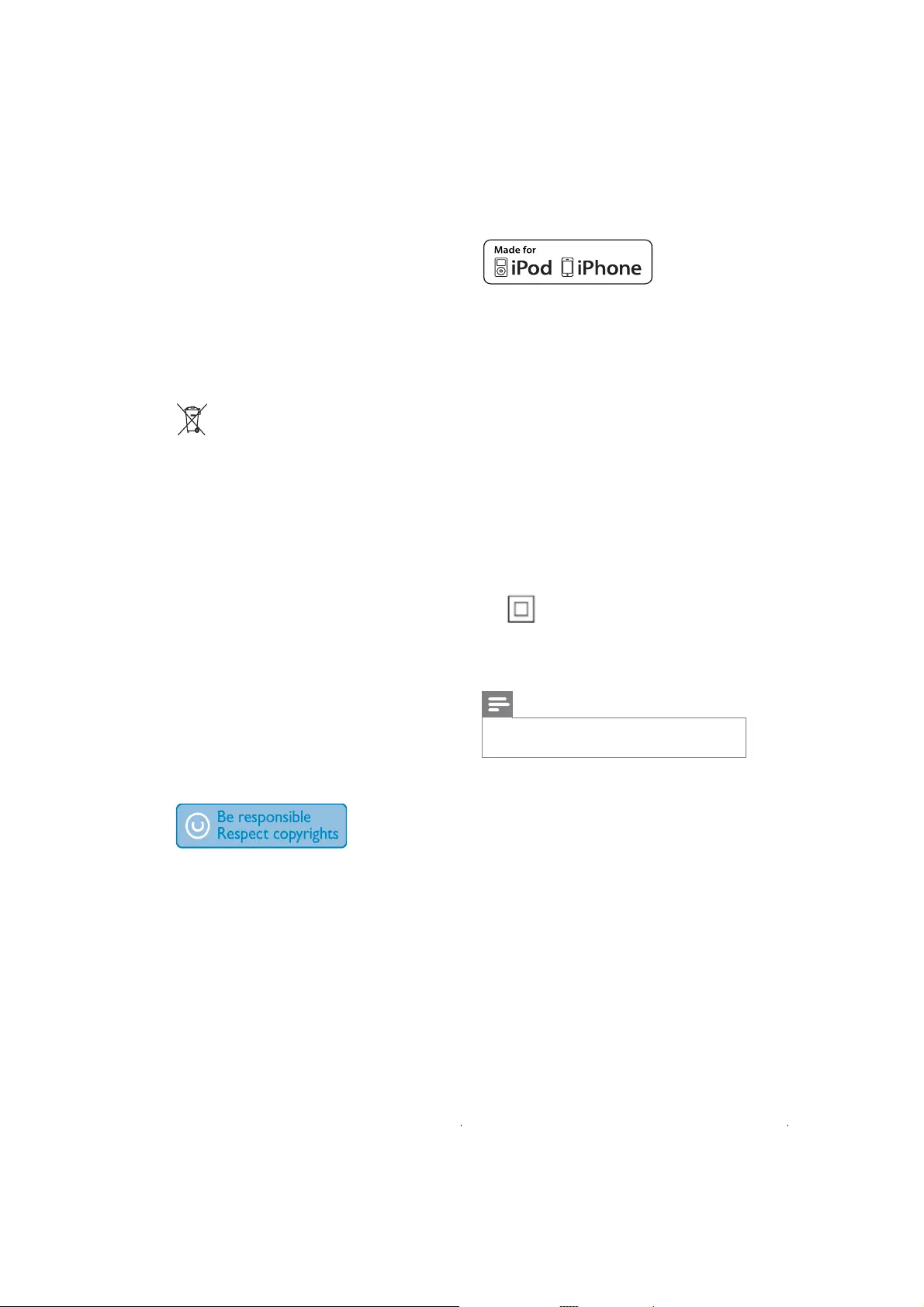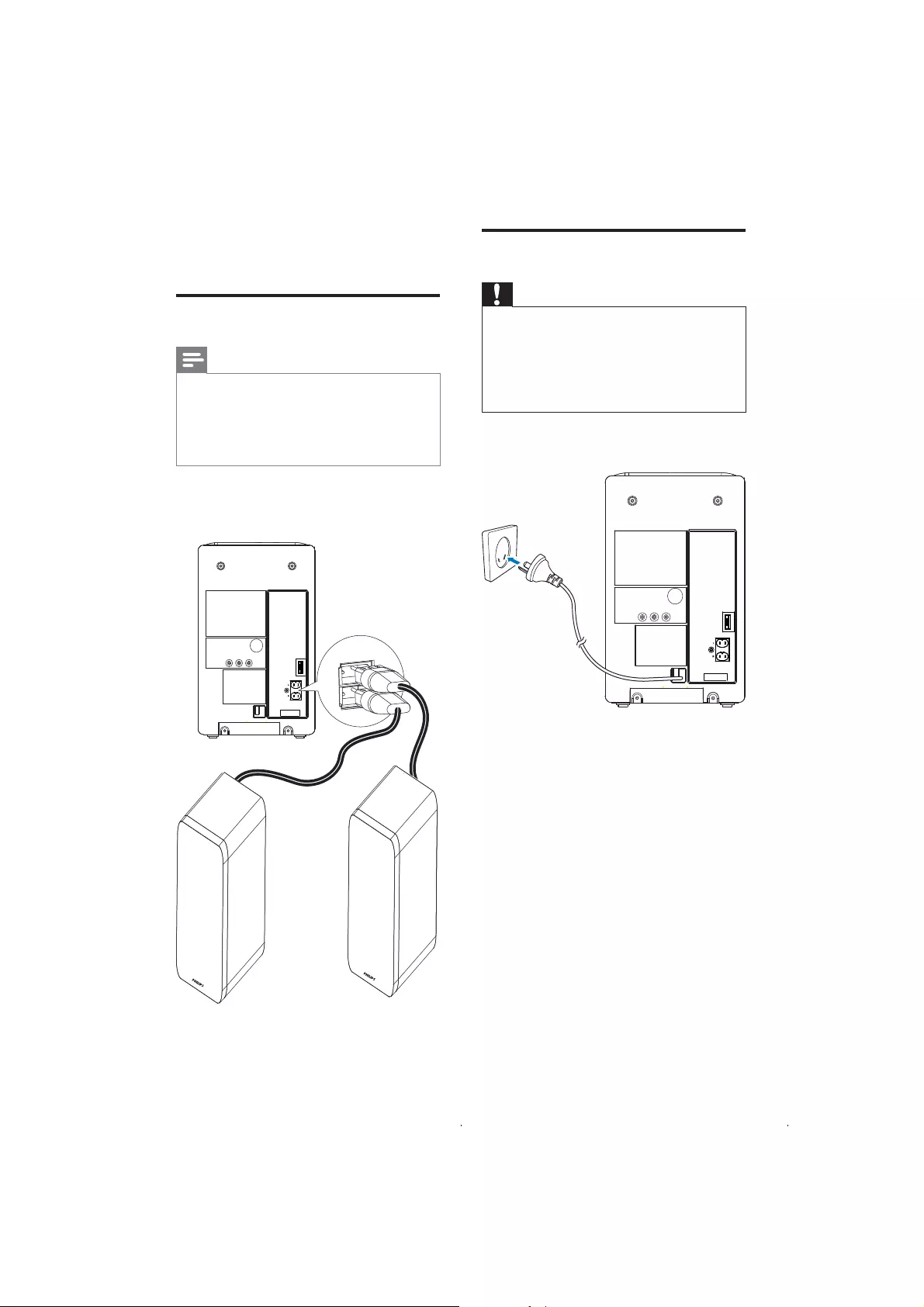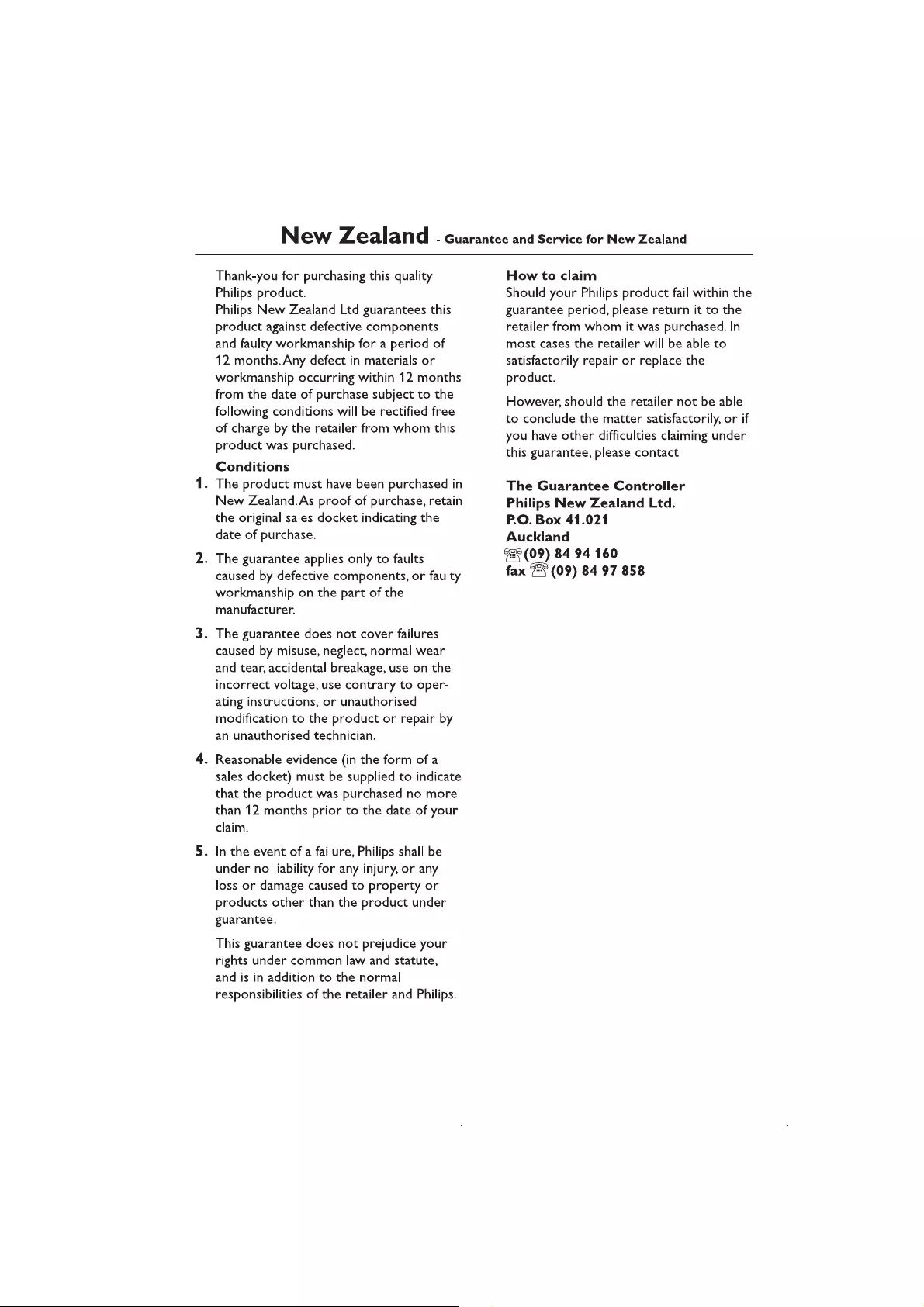Philips DCB188/79 User Manual
Displayed below is the user manual for DCB188/79 by Philips which is a product in the Home Audio Systems category. This manual has pages.
Related Manuals

DCB188
Register your product and get support at
www.philips.com/welcome
EN User manual


3EN
8 Listen to radio 15
Tune to a radio station 15
Program radio stations automatically 15
Program radio stations manually 15
Select a preset radio station 16
FM stations with RDS 16
9 Listen to Digital Audio Broadcast
(DAB) 17
Program DAB radio stations manually 17
Listen to preset DAB stations 17
Display DAB information 17
Use DAB menu 17
10 Other features 19
Set the alarm timer 19
Set the sleep timer 19
Listen to an external device 19
11 Product information 20
12 Troubleshooting 21
Contents
1 Important 4
Safety 4
Notice 5
2 Your Micro Hi-Fi System 7
Introduction 7
What’s in the box 7
Overview of the main unit 8
Overview of the remote control 9
3 Connect 11
Connect speakers 11
Connect power 11
4 Get started 12
5 Play disc 13
Play options 13
6 Play from iPod/iPhone 14
Compatible iPod/iPhone 14
Listen to iPod/iPhone through this player 14
Charge the iPod/iPhone 14
Remove the iPod/iPhone 14
7 Adjust volume level and
sound effect 15
Adjust volume level 15
Enhance bass 15
Select a preset sound effect 15
Mute sound 15

4
h Do not install near any heat sources
such as radiators, heat registers, stoves,
that produce heat.
i Protect the power cord from being
walked on or pinched, particularly at
plugs, convenience receptacles, and
the point where they exit from the
apparatus.
j Only use attachments/accessories
k Use only with the cart, stand, tripod,
manufacturer or sold with the apparatus.
When a cart is used, use caution when
moving the cart/apparatus combination
to avoid injury from tip-over.
l Unplug this apparatus during lightning
storms or when unused for long periods
of time.
m
personnel. Servicing is required when
the apparatus has been damaged in any
way, such as power-supply cord or plug
is damaged, liquid has been spilled or
objects have fallen into the apparatus,
the apparatus has been exposed to rain
or moisture, does not operate normally,
or has been dropped.
n Battery usage CAUTION – To prevent
battery leakage which may result in
bodily injury, property damage, or
damage to the unit:
Install all batteries correctly, + and -
as marked on the unit.
Do not mix batteries (old and new
or carbon and alkaline, etc.).
1 Important
Safety
Know these safety symbols
This ‘bolt of lightning’ indicates uninsulated
material within your unit may cause an
electrical shock. For the safety of everyone
in your household, please do not remove
product covering.
The ‘exclamation mark’ calls attention to
features for which you should read the
enclosed literature closely to prevent
operating and maintenance problems.
electric shock, this apparatus should not be
with liquids, such as vases, should not be
placed on this apparatus.
CAUTION: To prevent electric shock, fully
insert the plug. (For regions with polarized
plugs: To prevent electric shock, match wide
blade to wide slot.)
Important Safety Instructions
a Read these instructions.
b Keep these instructions.
c Heed all warnings.
d Follow all instructions.
e Do not use this apparatus near water.
f Clean only with dry cloth.
g Do not block any ventilation openings.
Install in accordance with the
manufacturer’s instructions.
EN

5
Slowly increase the sound until you can
hear it comfortably and clearly, without
distortion.
Listen for reasonable periods of time:
Prolonged exposure to sound, even
at normally ‘safe’ levels, can also cause
hearing loss.
Be sure to use your equipment
reasonably and take appropriate breaks.
Be sure to observe the following guidelines
when using your headphones.
Listen at reasonable volumes for
reasonable periods of time.
Be careful not to adjust the volume as
your hearing adapts.
Do not turn up the volume so high that
you can’t hear what’s around you.
You should use caution or temporarily
discontinue use in potentially hazardous
situations. Do not use headphones while
operating a motorized vehicle, cycling,
hazard and is illegal in many areas.
Notice
device that are not expressly approved by
Philips Consumer Lifestyle may void the user’s
authority to operate the equipment.
Your product is designed and manufactured
with high quality materials and components,
which can be recycled and reused.
When this crossed-out wheeled bin symbol
is attached to a product it means that the
product is covered by the European Directive
Remove batteries when the unit is
not used for a long time.
Batteries (battery pack or batteries
installed) shall not be exposed to
or the like.
o Apparatus shall not be exposed to
dripping or splashing.
p Do not place any sources of danger on
lighted candles).
q Where the plug of the Direct Plug-
in Adapter is used as the disconnect
device, the disconnect device shall
remain readily operable.
Caution
Use of controls or adjustments or
performance of procedures other than herein
may result in hazardous radiation exposure or
other unsafe operation.
Hearing safety
Listen at a moderate volume.
Using headphones at a high volume can
impair your hearing. This product can
produce sounds in decibel ranges that
may cause hearing loss for a normal
person, even for exposure less than a
minute. The higher decibel ranges are
offered for those that may have already
experienced some hearing loss.
Sound can be deceiving. Over time your
hearing ‘comfort level’ adapts to higher
volumes of sound. So after prolonged
listening, what sounds ‘normal’ can
actually be loud and harmful to your
hearing. To guard against this, set your
volume to a safe level before your hearing
adapts and leave it there.
To establish a safe volume level:
Set your volume control at a low setting.
EN

6
“Made for iPod” and “Made for iPhone”
mean that an electronic accessory has been
the developer to meet Apple performance
standards. Apple is not responsible for the
operation of this device or its compliance with
safety and regulatory standards. Please note
that the use of this accessory with iPod, or
iPhone may affect wireless performance.
Apple is not responsible for the operation of
this device or its compliance with safety and
regulatory standards.
iPod and iPhone are trademarks of Apple Inc.,
registered in the U.S. and other countries.
Class II equipment symbol
This symbol indicates that the unit has a
double insulation system.
Note
The type plate is located at the rear of the
apparatus.
Please inform yourself about the local separate
collection system for electrical and electronic
products.
Please act according to your local rules and
do not dispose of your old products with your
normal household waste. Correct disposal of
your old product helps to prevent potential
negative consequences for the environment
and human health.
Your product contains batteries covered by
cannot be disposed with normal household
waste.Please inform yourself about the local
rules on separate collection of batteries
because correct disposal helps to prevent
negative consequences for the environmental
and human health.
Environmental information
All unnecessary packaging has been omitted.
We have tried to make the packaging easy to
separate into three materials: cardboard (box),
polystyrene foam (buffer) and polyethylene
(bags, protective foam sheet.)
Your system consists of materials which can
be recycled and reused if disassembled by
a specialized company. Please observe the
local regulations regarding the disposal of
packaging materials, exhausted batteries and
old equipment.
The making of unauthorized copies of
copy-protected material, including computer
recordings, may be an infringement of
copyrights and constitute a criminal offence.
This equipment should not be used for such
purposes.
EN

7
2 Your Micro Hi-
Fi System
Congratulations on your purchase, and
support that Philips offers, register your product
at www.Philips.com/welcome.
Introduction
With this unit, you can:
enjoy audio from audio CDs, iPod players,
iPhone and other external devices
listen to radio stations and Digital Audio
Broadcasting (DAB) radio stations
You can enrich sound output with the
sound effect:
Dynamic Bass Boost (DBB)
Digital Sound Control (DSC)
The unit supports the following media format:
What’s in the box
Check and identify the contents of your
package:
Main unit
MP3 link cable x 1
Remote control
User manual
Quick start guide
EN

8
Overview of the main unit
b
a
c
d
e
f
g
h
g
i
j
k
l
DSC
EN

9
Overview of the remote
control
a POWER
Switch on/off the unit
Switch to standby mode.
b Source selection keys (DISC,
TUNER/DAB, AUX,iPhone/iPod)
Select a source: CD, tuner/DAB,
MP3 LINK, or iPod/iPhone.
c INFO/RDS
Switch to FM RDS mode
Display DAB info.
k
b
c
d
e
f
g
h
i
j
a
l
m
n
o
p
q
r
a OPEN/CLOSE
Open or close the disc tray.
b POWER
Turn on the unit, switch to standby
mode.
c SOURCE
Select a source: Disc, Tuner, MP3
LINK, or iPod/iPhone.
d
Start or pause play.
e
Stop play or erase a program.
f MP3 LINK
Jack for an external audio device.
g iPod/iPhone dock
h DSC
Select a preset sound setting: POP,
JAZZ, CLASSIC or ROCK.
i MENU
Access DAB menu.
j /
Skip to the previous/next track.
Search within a track/ disc.
Tune to a radio station.
Adjust time.
k Remote control sensor
l VOLUME
Adjust volume.
EN

q TIMER/SLEEP
Set the alarm timer.
Set the sleep timer.
r MUTE
Mute volume.
d CLOCK/DISPLAY
Set the clock.
View the clock.
During play, select display
information.
e SCAN
Select DAB auto scan or FM auto
scan
f PRESET/ALBUM
Navigate through the iPod/iPhone
menu.
Skip to the previous/next album.
Select a preset radio station.
g /
Fast reverse or fast forward within a
track or disc.
Skip to the previous/next track.
Tune to a radio station.
Adjust time.
h DBB
Turns on or off dynamic bass
enhancement.
i
Start or pause play.
j VOL +/-
Adjust volume.
k
Stop play or erase a program.
l SHUFFLE
Play tracks randomly.
m REPEAT
Select a repeat play mode.
n PROG
Program tracks.
Program radio stations.
o OK
p MENU
Access the iPod/iPhone or DAB
menu.
EN

11
Connect power
Caution
Risk of product damage! Make sure that the
power supply voltage corresponds to the
voltage printed on the back or the underside
of the Micro Hi-Fi system.
Before connecting the AC power cord,
make sure that you have completed all other
connections.
1 Connect the AC power cord to the
power outlet.
3 Connect
Connect speakers
Note
For optimal sound, use the supplied speakers
only.
Connect only speakers with impedance that is
the same or higher than the supplied speakers.
manual.
1 Fully insert the plugs from the speakers
into the speaker sockets on the back of
the main unit.
EN

Note
If you are not going to use the remote control
for a long time, remove the batteries.
Do not use old and new or different types of
batteries in combination.
Batteries contain chemical substances, so they
should be disposed of properly.
Set clock
1 In the standby mode, press and hold
CLOCK/DISPLAY to activate the clock
setting mode.
»
displayed.
2 Press PROG
3 Press CLOCK/DISPLAY
»The hour digits are displayed and begin
to blink.
4 Press / to set the hour.
5 Press CLOCK/DISPLAY
»The minute digits are displayed and
begin to blink.
6 Press / to set the minute.
7 Press CLOCK/DISPLAY
Turn on
1 Press POWER.
»The product switches to the last
selected source.
Switch to standby
1 Press POWER to switch the unit to
standby mode.
»The clock (if set) appears on the
display panel.
4 Get started
Caution
Use the controls only as stated in this user
manual.
Always follow the instructions in this chapter
in sequence.
If you contact Philips, you will be asked for the
model and serial number of your apparatus. The
model number and serial number are on the
back of the apparatus. Write the numbers here:
Model No. _________________________
Serial No. __________________________
Prepare the remote control
Caution
Risk of explosion! Keep batteries away from
To insert the remote control battery:
1 Open the battery compartment.
2
with correct polarity (+/-) as indicated.
3 Close the battery compartment.
3
1
2
EN

13
Repeat play
1 During play, press REPEAT repeatedly to
select:
»[REP ALL] : all tracks are played
repeatedly.
»[REP ONE] : The current track is
played repeatedly.
2 To return to normal play, press REPEAT
repeatedly until repeat mode is no longer
displayed.
Random play
1 Press SHUFFLE.
»[SHUF] is displayed: all tracks are
played randomly.
2 To return to normal play, press SHUFFLE
again.
Note
at the same time.
Program tracks
1 In DISC mode, at the stop position
For MP3: press PRESET/ALBUM
to select an albume, and then
press / to select a track.
For CD: press / to select a
track.
2 Press PROG to store the track.
3
tracks to program.
4 Press to play the programmed tracks.
»During play, [PROG] is displayed.
To erase the program, in the stop
position, press .
»[PROG] disappears.
5 Play disc
Caution
Never look at the laser beam inside the unit.
Risk of product damage! Never play discs with
accessories such as disc stabilizer rings or disc
treatment sheets.
Do not push on the disc compartment or
put any objects other than discs on the disc
compartment. It may cause the disc player to
malfunction.
Note
1 Press DISC to select the disc source.
2 Lift the disc doorat the top of the unit.
3 Insert a disc with the printed side facing
up, then close the disc compartment.
4 Press to start play.
To pause/resume play, press .
To stop play, press .
Play options
Skip to a track
For CD:
1 Press / to select another track.
For MP3 discs:
1 Press PRESET/ALBUM to select an
album or folder.
2 Press /
Search within a track
1 During play, press and hold / .
2 Release to resume normal play.
Display play information
1 During play, press CLOCK/DISPLAY
repeatedly to select different play
information.
EN

14
Listen to iPod/iPhone through
this player
1 Place the iPod/iPhone in the dock.
»The unit switches to iPod/iPhone
mode automatically.
To start/pause/resume play, press
.
To skip to a track, press / .
To search during play: press and hold
/ , then release to resume
normal play.
To navigate the menu: press MENU,
then press / to select, and press
OK
Charge the iPod/iPhone
When the unit is connected to power, the
docked iPod/iPhone starts charging.
Tip
For certain iPod models, it may take up to a
minute before the charging indication appears.
Remove the iPod/iPhone
1 Pull the iPod/iPhone out of the dock.
6 Play from iPod/
iPhone
You can enjoy audio from iPod/iPhone through
this unit.
Compatible iPod/iPhone
dock connector.
Made for:
iPod with video (iPod 5th generation)
iPod nano (1st generation)
iPod nano (3rd generation)
iPod nano (4th generation)
iPod nano (5th generation)
iPod nano (6th generation)
iPod classic
iPod touch (1st generation)
iPod touch (3rd generation)
iPod touch (4th generation)
Works with:
iPhone
iPhone 3G
iPhone 3GS
iPhone 4.
EN

15
8 Listen to radio
Tune to a radio station
1 Press TUN repeatedly to select FM.
2 Press SCAN.
»The radio automatically tunes to a
3
To tune to a station with weak signal,
press / repeatedly until you
Program radio stations
automatically
radio stations.
1 In the FM tuner mode, press and
hold SCAN
automatic program mode.
»All available stations are stored in the
order of reception strength.
»
broadcast automatically.
Program radio stations
manually
radio stations.
1 Tune to a radio station. (See “Tune to a
radio station” section.)
2 Press PROG to activate program mode.
3 Press PRESET/ALBUM to allocate a
number to this radio station.
4 Press and hold PROG
5 Repeat the above steps to program other
stations.
7 Adjust volume
level and sound
effect
Adjust volume level
1 During play, press VOL +/- to increase/
decrease the volume level.
Enhance bass
1 During play, press DBB to turn on or off
dynamic bass enhancement.
»If DBB is activated, DBB is displayed.
Select a preset sound effect
1 During play, press DSC on the main unit
repeatedly to select:
[POP]
[JAZZ]
[ROCK]
[CLASSIC]
Mute sound
1 During play, press MUTE to mute/unmute
sound.
EN

16
Display RDS information
When the unit is on, the clock can be
automatically set by synchronizing with the
time signal broadcasts with the RDS signal.
This only works if the RDS station is sending
this time signal.
When clock synchronizing is turned on, clock
is synchronized with the time set by DAB or
RDS, and manually set clock is overwritten.
To turn on or off clock synchronizing:
1 In DAB or FM mode, press and hold
MENU
seconds to switch it on or off.
Note
Some RDS radio station may be transmitting
a real time clock at a minute interval. The
accuracy of the transmitted time depends on
the transmitting RDS radio station.
Tip
To overwrite a programmed station, store
another station in its place.
Select a preset radio station
1 In tuner mode, press PRESET/ALBUM
to select a preset number.
»The radio station stored under the
selected number is broadcasted.
Tip
Position the antenna as far as possible from
TV, VCR or other radiation source.
For optimal reception, fully extend and adjust
the position of the antenna.
FM stations with RDS
Radio Data System (RDS) is a service that
sends additional broadcast information along
with FM stations.
If you listen to a FM station with RDS signal,
“RDS” displays.
Display RDS information
1 Tune to the desired RDS radio station on
the FM waveband.
2 Press INFO/RDS on the remote control
repeatedly to switch through the
following information (if available):
Station name
Program type (for example: News,
Sport, etc.)
Frequency
Stereo/Mono Mode
Current time
Date
EN

17
Listen to preset DAB stations
1 In DAB mode, press PRESET/ALBUM
to select a preset number.
»The DAB station stored under the
selected number is broadcasted.
Display DAB information
line shows station name, and the second line
shows the service information for the current
station. 7 types of service information are
available.
1 Press INFO/RDS repeatedly to cycle
through the display information (if
available).
»Dynamic label segment (DLS)
»Program type (PTY)
»Ensemble Name
»Time
»Channel and frequency
»Bit rate and audio status
»Signal error rate
Use DAB menu
1 In the DAB mode, press MENU to enter
the DAB menu.
»[Manual tune]
displays.
2 Press / to scroll the menu options:
[Station list]
[Full scan]
[Manual tune]
[DRC]
[Prune]
[System]
3 To select an option, press OK.
9 Listen to
Digital Audio
Broadcast
(DAB)
Digital Audio Broadcasting (DAB), is a way
of broadcasting radio digitally through a
network of transmitters. It provides you with
more choice, better sound quality and more
information.
1 Press TUNERrepeatedly to select DAB.
2 PressSCAN.
»The system performs auto scan.
»All the available DAB stations is stored.
»
station.
Program DAB radio stations
manually
radio stations.
1 Tune to a DAB station.
2 Press PROG on the remote control to
activate programming.
3 Press / on the remote control to
4 Press and hold PROG
»The preset number of the saved
station appears.
Note
If a DAB station is already stored under a
preset location, new DAB station assigned
to this location will overwrite the old DAB
station.
DAB station presets will not overwrite FM
presets.
EN

18
2 Press / repeatedly until[DRC]
displays.
3 Press OK to enter the sub-menu.
»The current DRC level displays on the
4 Press / to select a DRC value
»[DRC Off], [DRC Low] and [DRC
High] displays on the second line.
5 Press OK
»You should be able to hear the
difference in compression immediately.
Note
The best way to determine which of these
DRC value settings suits you best is to
experiment with them on a variety of source
material.
Prune
This option will list active stations and remove
any stations that are in the list but have no
service in your area from the service list. Those
invalid stations in the service list have a question
mark (?) displayed in front of the station name.
1 Select Prune stations and press OK.
»All stations that have a question mark
will be deleted from the service list.
System
[SW version]: Display software
version of the unit.
[Factory reset]: Reset all the settings
of this unit to factory default. Press
OK
4
under one option.
Full scan
Full scan is used to perform a wide range of
DAB radio search.
1 In the DAB mode, press MENU to enter
the menu options.
2 Press / repeatedly until [Full scan]
displays.
3 Press OK
»Full scan starts automatically.
Manual tune
channel/frequency manually. In addition to
antenna orientation for better radio reception,
the optimal reception can also be obtained with
this feature.
1 In DAB mode, press MENU to display the
[Manual tune] option.
2 Press OK
»The display shows a channel and its
frequency.
3 Press / repeatedly until the desired
channel/frequency appears.
4 Press OK
Tip
You can press INFO/RDS to change the
service information on the display.
You can adjust the position of the antenna to
obtain the optimal signal strength.
Dynamic Range Control (DRC)
DRC adds or removes a degree of
compensation for the differences in the dynamic
range between radio stations.
There are three levels of compensation:
[DRC Off]: No compensation
applied. (the default)
[DRC Low]: Medium compensation
applied.
[DRC High]: Maximum
compensation applied.
1 In DAB mode, press MENU to enter the
menu options.
EN

19
Set the sleep timer
This unit can switch to standby automatically
after a set of time.
1 When the unit is on, press SLEEP
repeatedly to select a set of time (in
minutes).
»When sleep timer is activated, the
display shows .
To deactivate sleep timer
1 Press SLEEP repeatedly until “off” is
displayed.
»When sleep timer is deactivated,
disappears.
Listen to an external device
You can also listen to an external audio device
through this unit.
1 Press AUX to select MP3 link source.
2 Connect the supplied MP3 link cable to:
the MP3 LINK jack on this unit
the headphone jack on the device
3 Start to play the device. (See the device
user manual)
10 Other features
Set the alarm timer
Note
This player can set the Disc, Tuner, or iPod/
iPhone as the source for the alarm timer.
1 Make sure that you have set the clock
correctly.
2 In standby mode, press and hold TIMER.
3 Press DISC, TUN, or iPhone/iPod to
select a source.
4 Press TIMER
»The hour digits are displayed and begin
to blink.
5 Press / to set the hour.
6 Press TIMER
»The minute digits are displayed and
begin to blink.
7 Press / to set the minute.
8 Press TIMER
»The timer is set and activated.
Activate and deactivate alarm timer
1 In the standby mode, press SLEEP/TIMER
repeatedly to activate or deactivate timer.
»If timer is activated, the display shows
.
»If timer is deactivated, disappears.
Tip
Alarm timer is not available in MP3 LINK
mode.
If the DISC/iPod/iPhone source is selected but
no disc inserted or no iPod/iPhone connected,
the system will switch to the tuner source
automatically.
EN

Speakers
Speaker Impedance 4 ohm
Speaker Driver 3.5”
Sensitivity
General information
AC power
Operation Power
Consumption
Standby Power
Consumption
Dimensions
- Main Unit
(W x H x D)
- Speaker Box
(W x H x D)
Weight
- Main Unit
- Speaker Box
1.95 kg
Supported MP3 disc formats
Maximum title number: 999 (depending
Maximum album number: 99
44.1 kHz, 48 kHz
variable bit rates
11 Product
information
Note
Product information is subject to change
without prior notice.
!
"
Rated Output Power 15 W RMS
Frequency Response
Signal to Noise Ratio >65 dBA
Aux Input
Disc
Laser Type Semiconductor
Disc Diameter
Support Disc CD-DA, CD-R,
CD-RW, MP3-CD
Audio DAC
Total Harmonic
Distortion
<1%
Frequency Response
(44.1 kHz)
S/N Ratio >65 dBA
Tuner
Tuning Range
Tuning grid (FM)
Sensitivity
- Stereo, 46dB S/N Ratio
> 43 dBf
Search Selectivity
Total Harmonic
Distortion
Signal to Noise Ratio >55 dB
Number of presets
EN

#Insert the battery with its polarities (+/–
signs) aligned as indicated.
#Replace the battery.
#Aim the remote control directly at the
sensor on the front of the unit.
No disc detected
#Insert a disc.
#Check if the disc is inserted upside down.
#Wait until the moisture condensation at
the lens has cleared.
#Replace or clean the disc.
#
Poor radio reception
#Increase the distance between the unit
and your TV or VCR.
#Fully extend the antenna.
Timer does not work
#Set the clock correctly.
#Switch on the timer.
Clock/timer setting erased
#Power has been interrupted or the power
cord has been disconnected.
#Reset the clock/timer.
12 Troubleshooting
Caution
Never remove the casing of this apparatus.
To keep the warranty valid, never try to repair
the system yourself.
If you encounter problems when using this
apparatus, check the following points before
requesting service. If the problem remains
unsolved, go to the Philips web site (www.
philips.com/welcome). When you contact
Philips, ensure that the apparatus is nearby
and the model number and serial number are
available.
No power
#Ensure that the AC power cord of the
unit is connected properly.
#Ensure that there is power at the AC
outlet.
#As a power-saving feature, the system
switches off automatically 15 minutes
after track play reaches the end and no
control is operated.
No sound or poor sound
#Adjust the volume.
#Disconnect the headphones.
#Check that the speakers are connected
correctly.
#Check if the stripped speaker wires are
clamped.
Left and right sound outputs reversed
#Check the speaker connections and
location.
No response from the unit
#Disconnect and reconnect the AC power
plug, then turn on the system again.
Remote control does not work
#Before you press any function button,
remote control instead of the main unit.
#Reduce the distance between the remote
control and the unit.
EN

About DAB
About Digital Audio Broadcasting (DAB)
DAB digital radio is a new way of broadcasting
radio via a network of terrestrial transmitters.
It provides listeners with more choice and
information delivered in crystal clear, crackle-
free sound quality.
– The technology allows the receiver to lock on
– With DAB digital stations there are no
frequencies to remember, and sets are tuned
by station name, so there’s no returning on the
move.
What is a multiplex?
Digital radio operation is made up of a single
block of frequencies called a multiplex. Each
multiplex works within a frequency spectrum,
such as Band III for DAB broadcasts.
DAB BROADCASTERS AND DLS
Each DAB broadcaster (or multiplex operator)
also provides text and audio data services.
Some programmes are supported by Dynamic
Label Segments (DLS).This is data which you
can read as scrolling text on your DAB radio
display. Some stations transmit the latest news,
travel, and weather, what’s on now and next,
website addresses and phone numbers.
For more information on digital radio coverage
and services, please visit: www.drdb.org.
EN

EN

EN




© 2011 Koninklijke Philips Electronics N.V.
All rights reserved.
DCB188_79_UM_V1.0